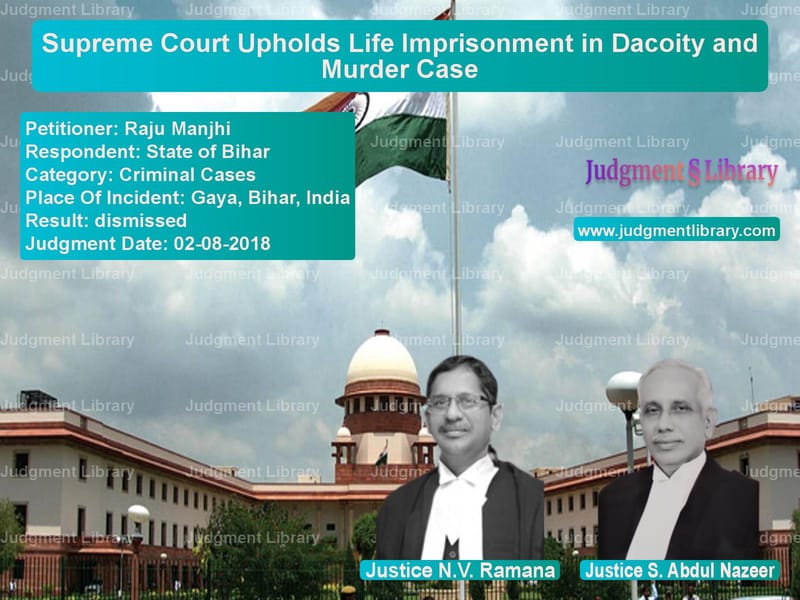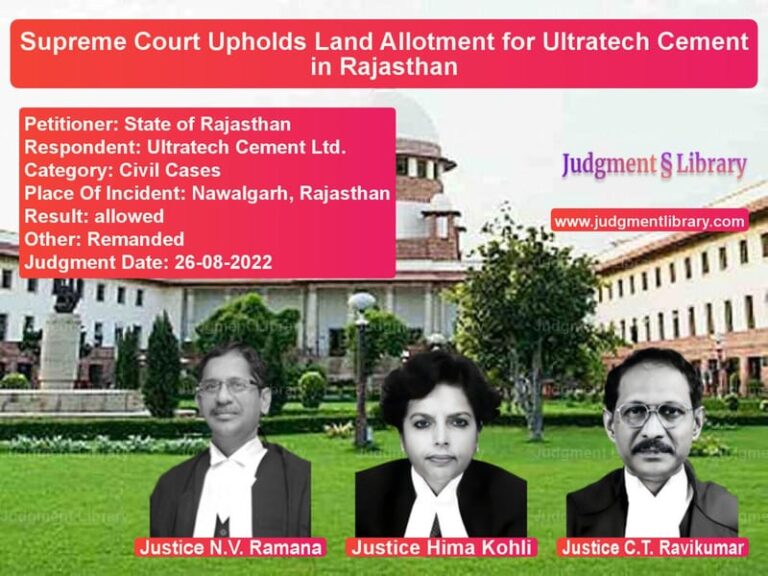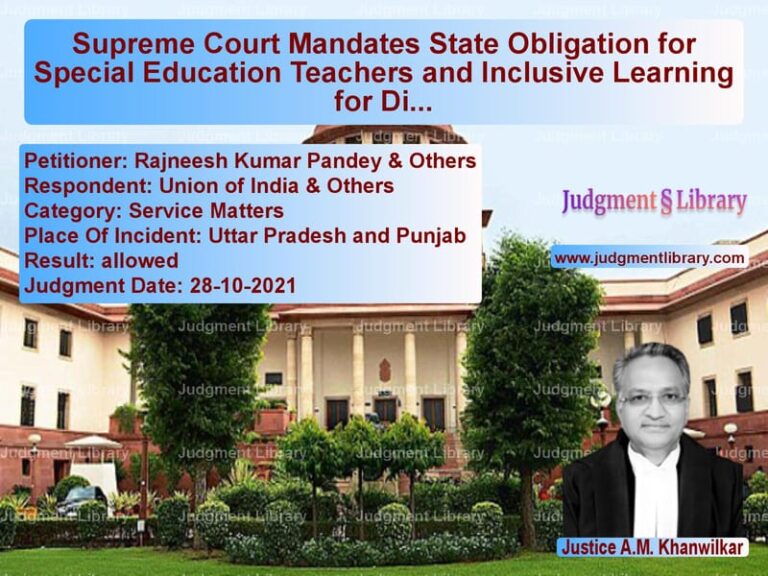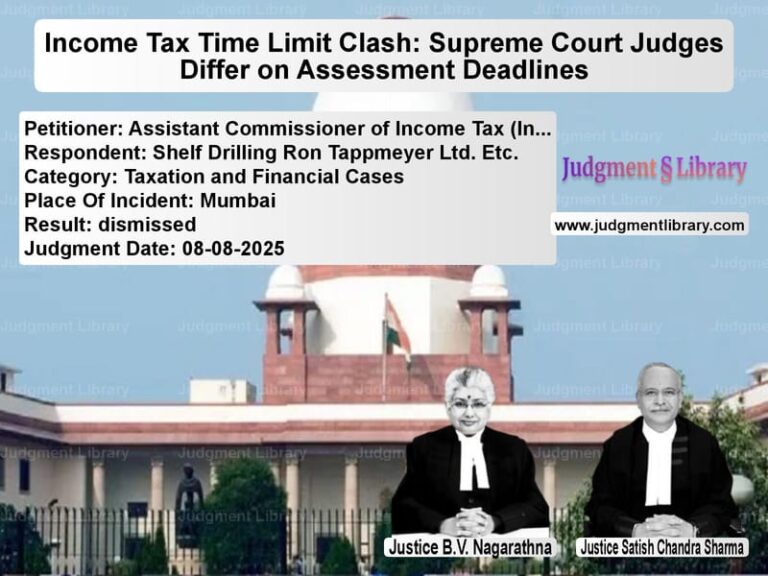Supreme Court Upholds Life Imprisonment in Dacoity and Murder Case
The Supreme Court of India, in its judgment dated August 2, 2018, upheld the conviction and life sentence of the appellant, Raju Manjhi, in a case involving dacoity and murder. The case, Raju Manjhi vs. State of Bihar, pertained to an armed robbery that resulted in the death of one of the victims. The appellant was found guilty under Section 396 of the Indian Penal Code (IPC), which deals with dacoity with murder.
The appellant had initially been convicted and sentenced to life imprisonment by the Additional District & Sessions Judge, Gaya. The Patna High Court upheld the conviction and sentence, following which the appellant moved the Supreme Court, arguing that the evidence against him was insufficient and that his conviction was based on weak circumstantial evidence.
Background of the Case
The case originated from an incident on the night of January 11-12, 1999, when a group of 10-12 assailants, including the appellant, allegedly broke into the house of Kamdeo Singh in the village of Banbareya, Gaya. The attackers looted gold ornaments, cash, and clothes worth approximately Rs. 25,000. When the family members resisted, they were assaulted, leading to severe injuries. The victim, Kameshwar Singh, succumbed to his injuries.
A complaint was lodged at 2 a.m. with the Moffasil police station, leading to an investigation and eventual arrest of some of the accused. The case was registered under Sections 395 (dacoity) and 412 (dishonestly receiving stolen property) of the IPC. However, after the death of Kameshwar Singh, Section 396 (dacoity with murder) was applied.
Petitioner’s Arguments
The appellant, Raju Manjhi, contended that:
- There was no concrete proof linking him to the crime.
- His conviction was based on weak circumstantial evidence.
- The police arrested him merely because he was present at his house when they conducted a raid.
- The recovery of Rs. 400 from his possession did not establish his involvement in the robbery or murder.
- None of the witnesses identified him in court or during the test identification parade.
- His alleged confession to the police was invalid as it was not recorded before a magistrate.
Respondent’s Arguments
The prosecution, representing the State of Bihar, countered these claims by stating:
- The appellant was one of the assailants who entered the house and was identified by the informant and other witnesses.
- He played an active role by guarding the entrance while the other accused ransacked the house.
- His confessional statement led to the recovery of incriminating material and looted cash.
- The investigating officer recovered bloodstained wooden sticks, which were used to assault the victims.
- The police had credible evidence proving his participation beyond a reasonable doubt.
Supreme Court’s Observations
The Supreme Court rejected the appellant’s plea, stating:
“In the case on hand, before looking at the confessional statement made by the accused-appellant in the light of Section 27 of the Evidence Act, it is clear that he had explained the way in which the accused committed the crime and shared the spoils.”
The Court further observed that the evidence gathered—including the statements of witnesses, recovery of looted property, and forensic evidence—was sufficient to convict the appellant beyond a reasonable doubt. The Court stated:
“The identification parade belongs to the stage of investigation, and there is no provision in the Code which obliges the investigating agency to hold or confers a right upon the accused to claim a test identification parade. Failure to hold a test identification parade would not make inadmissible the evidence of identification in court.”
The Court also dismissed the appellant’s claim that his confession was invalid, holding that his statement led to the recovery of stolen property, which strengthened the prosecution’s case.
Final Verdict
The Supreme Court upheld the conviction and sentence, ruling:
“In view of the foregoing discussion and having regard to the facts and circumstances of the case, we have no hesitation to conclude that the prosecution has proved the case against the accused-appellant beyond all reasonable doubts. Consequently, the appeal preferred by the accused being bereft of any substance, the same stands dismissed.”
Conclusion
The ruling in Raju Manjhi vs. State of Bihar reaffirms the principle that conviction in serious crimes like dacoity and murder does not necessarily require direct eyewitness testimony if there is strong corroborative evidence. The judgment also clarifies the validity of confessional statements when they lead to the discovery of incriminating material. The Supreme Court’s decision highlights the importance of circumstantial evidence in securing convictions and ensuring justice for victims.
Petitioner Name: Raju Manjhi.Respondent Name: State of Bihar.Judgment By: Justice N.V. Ramana, Justice S. Abdul Nazeer.Place Of Incident: Gaya, Bihar, India.Judgment Date: 02-08-2018.
Don’t miss out on the full details! Download the complete judgment in PDF format below and gain valuable insights instantly!
Download Judgment: Raju Manjhi vs State of Bihar Supreme Court of India Judgment Dated 02-08-2018.pdf
Direct Downlaod Judgment: Direct downlaod this Judgment
See all petitions in Murder Cases
See all petitions in Bail and Anticipatory Bail
See all petitions in Theft and Robbery Cases
See all petitions in Judgment by N.V. Ramana
See all petitions in Judgment by S. Abdul Nazeer
See all petitions in dismissed
See all petitions in supreme court of India judgments August 2018
See all petitions in 2018 judgments
See all posts in Criminal Cases Category
See all allowed petitions in Criminal Cases Category
See all Dismissed petitions in Criminal Cases Category
See all partially allowed petitions in Criminal Cases Category







